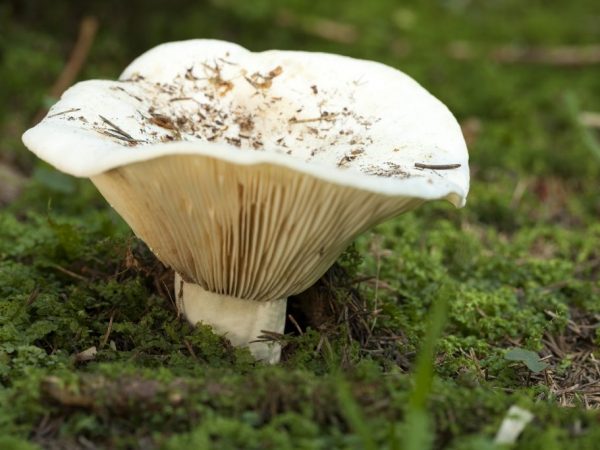Description of the mushroom peppercorn
Pepper milk is a lamellar mushroom from the russula family of the genus Mlechnik, class Agaricomycetes. It is a conditionally edible species.

Description of the mushroom peppercorn
Botanical characteristic
The fruit body of the peppercorn has a typical cap-toothed structure. Its mushroom cap can be from 6 to 30 cm in diameter.It changes its shape as the mushroom matures:
- at the initial stage, in young specimens, the cap is convex, its edges are bent towards the mushroom leg;
- over time (in adult specimens) it becomes funnel-shaped, the edges straighten and become wavy.
The surface is usually in shades of white, sometimes milky, matte, smooth or velvety to the touch. The central part of the mushroom cap is noticeably darker than the edges. Under mechanical stress, the cap cracks, and it is covered with specks of a yellow-brown hue.
The mushroom plates are often planted, narrow in width, descend along the mushroom stem, in some cases bifurcate. Many short plates are located between the main large plates. The original white color changes over time to a milky cream.
A thick and sticky white milky juice, which has a pungently burning taste, is released from a peppercorn when cut. In the process of drying, the milky juice sometimes changes color from white to slightly yellowish.
The mushroom leg grows up to 4-8 cm in length, its diameter is up to 1.2-3 cm. In color, it is closer to white. The structure is solid and dense, the surface is smooth or slightly wrinkled. Closer to the base, the leg narrows.
Irina Selyutina (Biologist):
As it turned out, there is a reaction with a solution of ferrous sulfate (FeSO4), in which the flesh turns into a creamy pink color. But when applied to a cut of caustic potassium (KOH) - alkali, its color does not change.
The mushroom pulp is whitish, dense, but brittle.
Similar varieties
Pepper milkman has varieties similar in appearance, including:
- violinist: characterized by a pubescent surface of the cap and legs, as well as less often planted plates:
- bluish lump: its milky juice in the process of drying changes color from white to gray-green;
- parchment milkman: has a mushroom leg of greater height and a wrinkled cap.
Growing geography

Mushrooms begin to grow in the second half of summer
The most preferred places for the growth of peppermint are damp shaded places among deciduous trees, mixed forests. Less often it can be found in thickets of coniferous trees. It is mycorrhizal and grows in symbiosis with tree roots.
Depending on the region, active fruiting of the peppermint begins in the second half of summer, from July, and lasts all autumn, until mid-November.
Milk mushrooms grow both singly and in rows, or arrange their colonies in the form of a circle. They love drained clay soil. They meet quite often.The geography of distribution covers almost all regions of central Russia, less often this mushroom is found in the northern regions.
Practical use
Pepper milk is used in cooking and medicine.
Cooking
The mushroom belongs to the 4th category of gastronomic value. Due to the specific pungent-bitter taste, pepper milk is considered inedible or conditionally edible, but only after prolonged preliminary soaking, prolonged heat exposure and salting, which allows you to remove the stinging taste of milky juice.
Irina Selyutina (Biologist):
Although pepper milk mushrooms are not in great demand among Russian fans of mushroom dishes because of their specific taste, however, everyone who cooked them is sure that properly processed mushrooms can compete in taste with species that have a higher gastronomic characteristic.
The collected pepper mushrooms must be soaked in cold water for 1-2 hours immediately upon returning from the forest (this will make them more resistant to mechanical stress) and you can process them thoroughly and without problems. The processing is as follows:
- Remove the skin from the cap with a knife.
- Remove the plates (they do this for large mushrooms, but do not touch the small ones).
- Cut off the leg, leaving the "stump" flush with the cap and remove the outer layer from it. By the way. If the leg is "gnawed" by slugs, it is removed completely.
After that, the mushrooms are thoroughly washed and sent for a long soaking - 3 or more days. Having folded it into a deep dish, place the container in a cold place, fill it with water. The water is changed several times a day to completely remove the bitterness. The peppermill is then ready to use.
Advice. Wear rubber gloves to prevent the milky juice from staining your hands and causing irritation.
In some cases, the lactarius is dried by grinding into a powdery mixture and used as a seasoning instead of hot pepper in cooking.
The medicine
Pepper milk is used for medicinal purposes. It has a neutralizing and destructive effect on the tubercle bacillus (Koch's bacillus). Traditional healing uses peppermint for the treatment of kidney and cholelithiasis. Mushroom pulp is pre-fried.
dzs_videogallery]
Conclusion
A member of the russula family, a representative of the genus Millechnik - a peppery milk mushroom, is a conditionally edible mushroom. Its use for food purposes is limited by the specific pungent-bitter aftertaste imparted to the pulp by milky juice. Its use in cooking is permissible in the form of a dried spice substitute. It is also used for medical purposes in the treatment of tuberculosis. It is used by traditional healers to treat certain diseases.



